Tradizioni e feste pagane - Sant'Antoni de Su Fogu, Laconi (Sardegna). (ITA-ENG)
Ciao Cari amici ci Hive, oggi voglio raccontarvi di una festa molto sentita del mio paese, e naturalmente anche da me. La festa in questione riguardano Sant’Antonio Abate, o detto in dialetto Laconese, Sant’Antoni de su Fogu.
Hi Dear Hive friends, today I want to tell you about a very heartfelt celebration in my country, and of course also by me. The feast in question concerns Sant'Antonio Abate, or called in the Laconese dialect, Sant'Antoni de su Fogu.

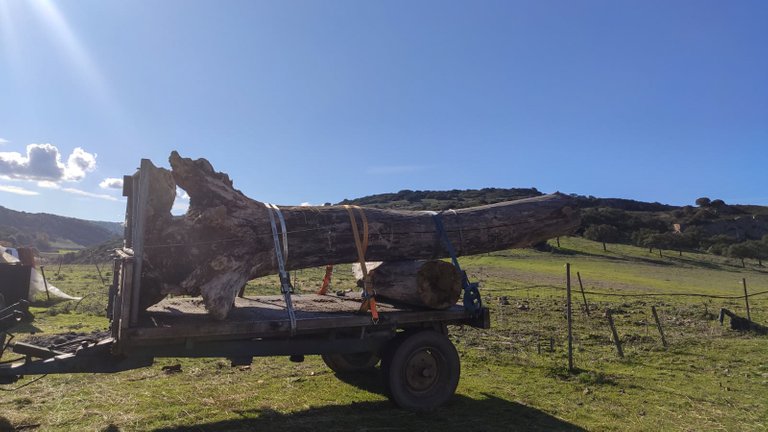
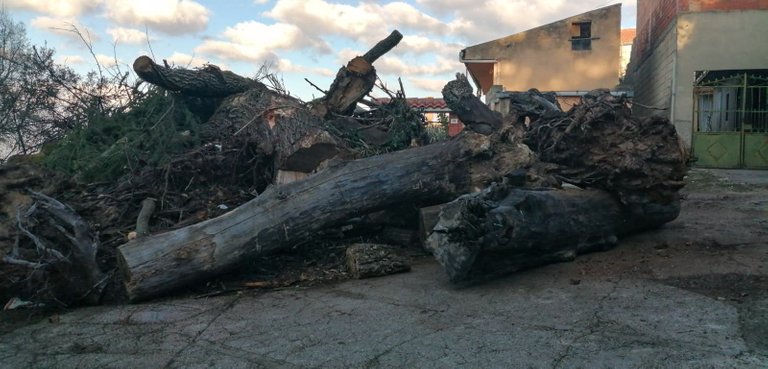

Si narra che l’Epifania tutte le feste si porta via, ma questo non succede in Sardegna, infatti nei giorni 16 e 17 Gennaio, si festeggia S’Antantoni De Su Fogu (Sant’Antonio Abate), una festività molto sentita in tutta la Sardegna, ma in particolar modo a Laconi, infatti questa festa, apre ufficialmente il carnevale in Sardegna. A Laconi, infatti nella giornata del 16 gennaio, la maschera tradizionale Laconese, chiamata Su Corongiaiu, fa appunto la sua prima uscita e apre come dicevo poco fa, il carnevale. Per i Laconesi, questa è una delle feste più sentite.
L’organizzazione, inizia già dalla primavera dell’anno prima, infatti, Is Fedalis (sarebbero le leve ), gruppi di amici, e a volte singole persone si riuniscono per organizzare la festa, quando lo organizza una singola persona, è perché è stata fatta una promessa al Santo, che se gli fa una Grazia, l’anno seguente, organizzerà una festa per donare il tronco per il tradizionale Falò.
Tutto ha inizio con delle riunioni che vengono organizzate, ad esempio, da Is Fedalis, quando si riuniscono, per prima cosa, devono sapere quanti di loro parteciperanno all’organizzazione. Una volta che si sa quanti saranno i partecipanti, si decide una quota in denaro che ciascuno dovrà mettere. Nella quota, ognuno potrà avere un certo numero di invitati, (solitamente sono tre), se poi vuole invitarne di più, dovrà aggiungere una quota per ogni invitato.
Dopo qualche tempo, si riuniscono nuovamente, si fa il conteggio totale dei partecipanti, in modo che si possa conteggiare la somma di denaro totale per organizzare il tutto.
I soldi racimolati, serviranno per comprare maialetti, agnelli, il fantastico dolce de Su Pani ‘e Saba, vino (che deve essere a volontà, perché se in questa occasione se non avanzasse il vino anche per il giorno dopo, è come se fosse stato fatto un delitto), affittare la location per il pranzo e il trattore, solitamente la location e il trattore vengono concessi gratuitamente, anche perché viene invitato alla festa il proprietario, e poi perché essendo una festa molto sentita dai Laconesi, non riuscirebbe mai a farsi pagare. Quei soldi risparmiati, verranno utilizzati per comprare altro vino.
It is said that the Epiphany takes away all the holidays, but this does not happen in Sardinia, in fact on 16 and 17 January, S'Antantoni De Su Fogu (Sant'Antonio Abate) is celebrated, a very heartfelt festivity throughout the Sardinia, but especially in Laconi, in fact this festival officially opens the carnival in Sardinia. In Laconi, in fact, on January 16th, the traditional Laconese mask, called Su Corongiaiu, makes its first outing and opens the carnival, as I said just now. For the Laconesi, this is one of the most heartfelt celebrations.
The organization already starts from the spring of the previous year, in fact, Is Fedalis (they would be the levers), groups of friends, and sometimes single people get together to organize the party, when a single person organizes it, it is because it was done a promise to the Saint, that if he grants him a favour, the following year, he will organize a party to donate the trunk for the traditional bonfire.
It all begins with the meetings that are organized, for example, by Is Fedalis, when they meet, first of all, they must know how many of them will participate in the organization. Once you know how many participants there will be, you decide on a share of money that everyone will have to contribute. In the quota, everyone can have a certain number of guests (usually there are three), if he then wants to invite more, he will have to add a quota for each guest. After some time, they get together again, the total number of participants is counted, so that the total amount of money can be counted to organize everything.
The money raised will be used to buy piglets, lambs, the fantastic dessert of Su Pani 'e Saba, wine (which must be at will, because if on this occasion if there is no wine left over for the next day, it is as if it had been committed a crime), rent the location for lunch and the tractor, usually the location and the tractor are granted free of charge, also because the owner is invited to the party, and then because being a party deeply felt by the Laconesi, he would never be able to to pay. That money saved will be used to buy more wine.

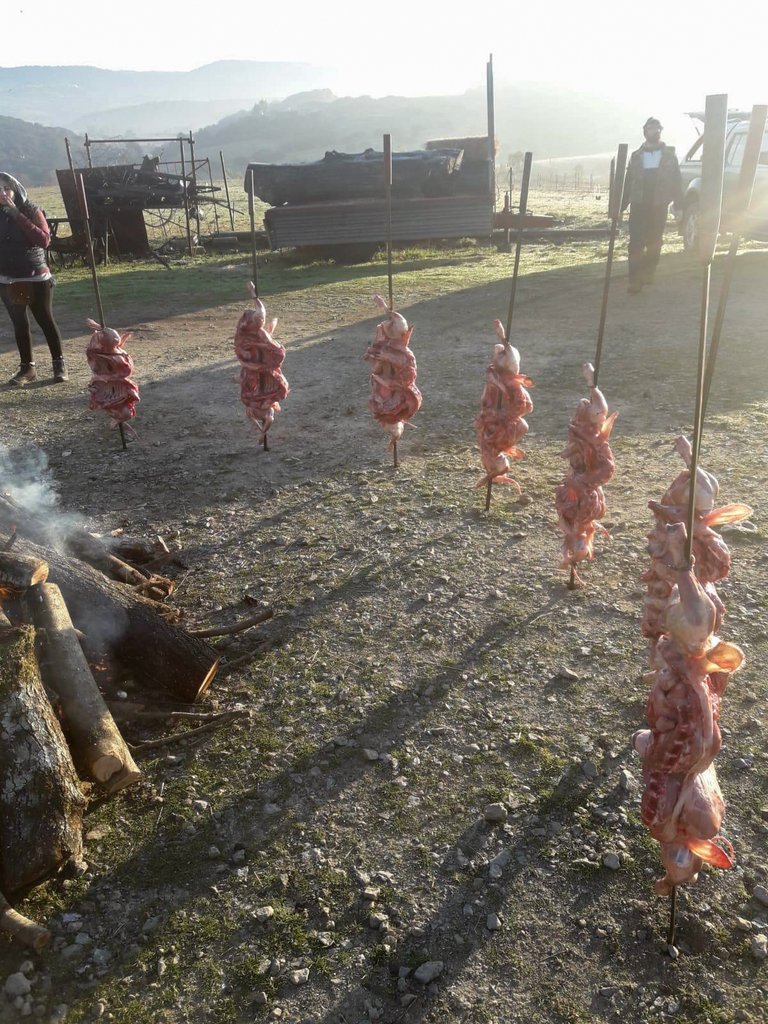

Su Fogone (il Falò), per i Laconesi, alcuni anni inizia già dal primo giorno dell’anno, questo perché si arriva anche a organizzare anche 20 pranzi in sedici giorni. Ma entriamo più nel dettaglio di questa festa. Le feste vengono organizzate perché ogni gruppo, andrà a donare al Santo un grande tronco, che servirà poi per la festa religiosa del 16 Gennaio.
Solitamente per quanto riguarda le leve che organizzano sono ogni anno le stesse, cioè diciottenni, ventenni, venticinquenni, e così via si va avanti di cinque anni, e si può arrivare anche a festeggiare fino anche ai settantenni. Ma adesso è arrivato il momento di farvi divertire, vi racconto quello che succede a ogni pranzo, pensate che a questi pranzi può arrivare a partecipare mezzo paese, si possono trovare da neonati, a persone di ottant’anni.
Come dicevo prima, questi pranzi sono sparsi nei giorni che vanno dal primo al sedici gennaio. Naturalmente sono più concentrati nel weekend.
Gli organizzatori, i giorni prima del pranzo, vanno a sistemare la location (che sarebbe un cappannone in campagna), sistemano le postazioni dove verrà acceso il fuoco per cucinare maialetti e agnelli. Gli uomini, con l’aiuto di tanti amici/ invitati, posizionano il grande tronco che verrà portato il giorno del pranzo nel piazzale della Chiesa, nel carrello del trattore, e nel frattempo iniziano ad assaggiare il vino per essere sicuri che sia buono…
Arriva il giorno vero e proprio dell’inizio dei festeggiamenti in onore del Santo.
Su Fogone (the Bonfire) for the Laconesi, some years it begins starts from the first day of the year, this because even 20 lunches are organized in sixteen days. But let's go into more detail about this party. The parties are organized because each group will donate a large trunk to the Saint, which will then be used for the religious festival of January 16th. As far as the recruits who organize are concerned, they are usually the same every year, that is, eighteen, twenty, twenty-five, and so on, it goes on five years, and you can even celebrate up to the seventy-year. But now the time has come for you to have fun, I'll tell you something that happens at every lunch, think that half the country can participate in these lunches, they can be found from newborns to eighty-year-olds.
As I said before, these lunches are scattered over the days from January 1st to 16th. Naturally they are more concentrated on the weekend. The organizers, the days before lunch, go to arrange the location (which would be a shed in the countryside), arrange the stations where the fire will be lit to cook piglets and lambs. The men, with the help of many friends/guests, place the large trunk that will be brought on the day of lunch in the church square, in the tractor trolley, and in the meantime they begin to taste the wine to be sure it is good... The real day of the beginning of the celebrations in honor of the Saint arrives.



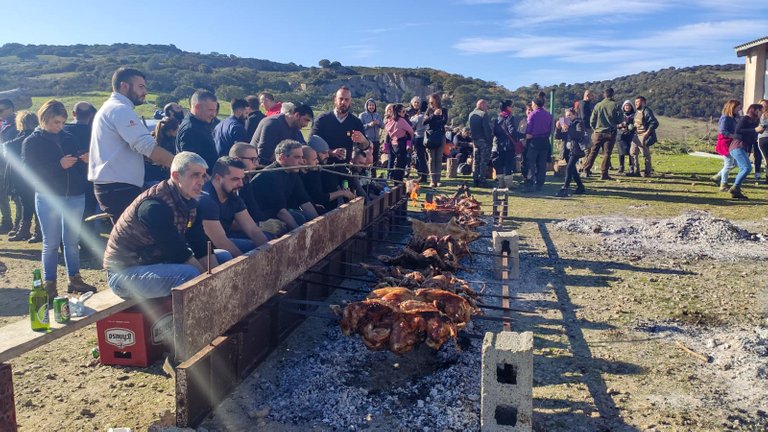
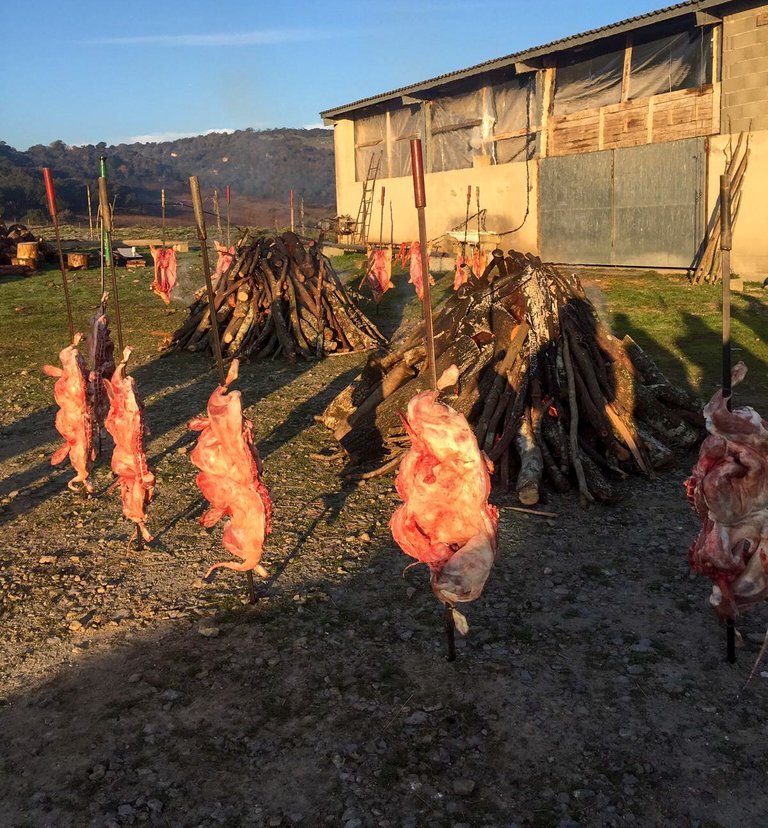

Si arriva in campagna molto presto, le donne iniziano con i preparativi della sala, mentre gli uomini iniziano ad accendere il fuoco per le prelibatezze che andranno ad arrostire. Ecco che a metà mattinata, iniziano ad arrivare i primi invitati, e si comincia a mangiare e a bere. Si inizia con gli antipasti di salsiccia, guanciale , formaggio, olive, verdure sott’olio e sotto aceto, e per mandare giù tutto questo cibo vino a volontà.
Intanto il tempo passa tra chiacchiere, bambini che corrono da tutte le parti, trallalera, (canzoni inventate al momento con una melodia particolare), ragazzi e uomini adulti che si sfidano a Sa Murra e persone che semplicemente le osservano, ragazzi che suonano la fisarmonica e altri che ballano il ballo sardo.
We arrive in the countryside very early, the women start preparing the dining room, while the men start lighting the fire for the delicacies they are going to roast. Here in mid-morning, the first guests begin to arrive, and we start eating and drinking. It starts with appetizers of sausage, bacon, cheese, olives, vegetables in oil and vinegar, and to wash down all this food, wine at will. Meanwhile, time passes between chatter, children running everywhere, trallalera, (songs invented on the spot with a particular melody), boys and grown men who challenge each other in Sa Murra and people who simply observe them, boys playing the accordion and others who dance the Sardinian dance.

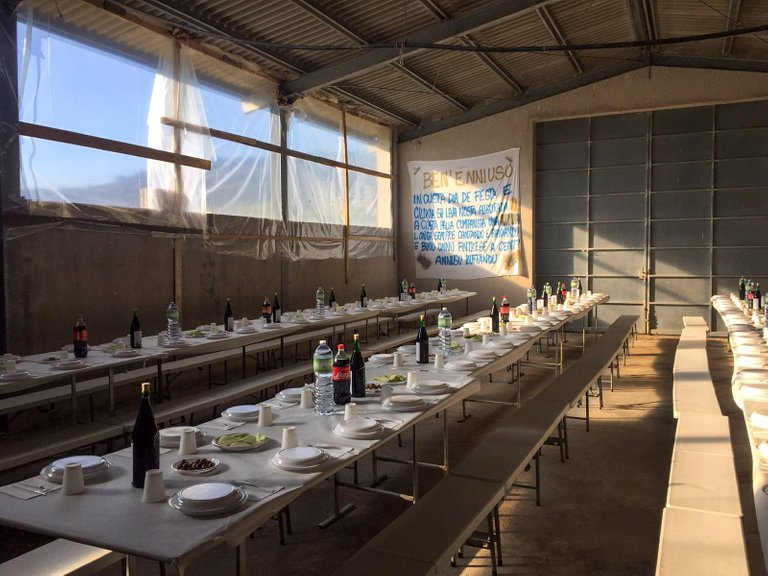

Vi spiego un attimo in cosa consiste il gioco de Sa Murra. Solitamente si sfidano due coppie, ci dev’essere un arbitro, che tiene il punteggio. I partecipanti devono avere molta abilità, velocità e mente fredda… I giocatori si sfidano a coppie, muovendo velocemente le braccia, facendo un gesto con le dita, e dicendo secondo loro quale sarà il numero totale esatto, chi dice il numero esatto, sfida l’altro giocatore, si va avanti fino a quando non si raggiunge il punteggio che si era deciso in precedenza. A me questo gioco mi affascina moltissimo, vedi i giocatori muovere le mani con una velocità impressionante, e poi la grinta che ci mettono è una figata.
Let me explain for a moment what the game of Sa Murra consists of. Usually two couples challenge each other, there must be a referee, who keeps the score. The participants must have a lot of skill, speed and a cold mind… The players challenge each other in pairs, moving their arms quickly, making a gesture with their fingers, and saying according to them what the exact total number will be, whoever says the exact number challenges the other player, this continues until the score that was previously decided is reached. This game fascinates me a lot, you see the players move their hands with impressive speed, and then the grit they put into it is cool.

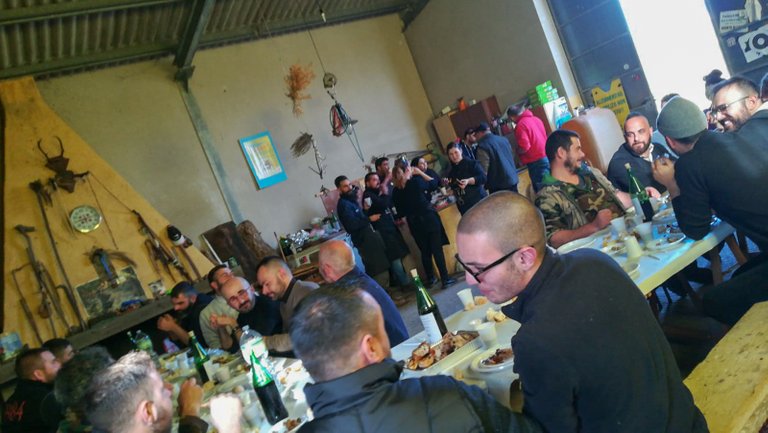
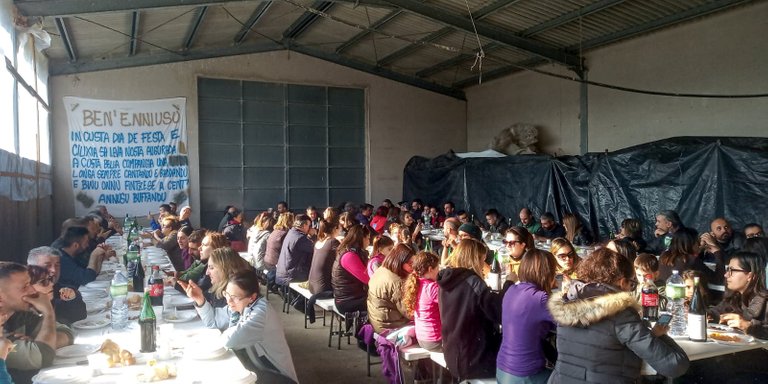
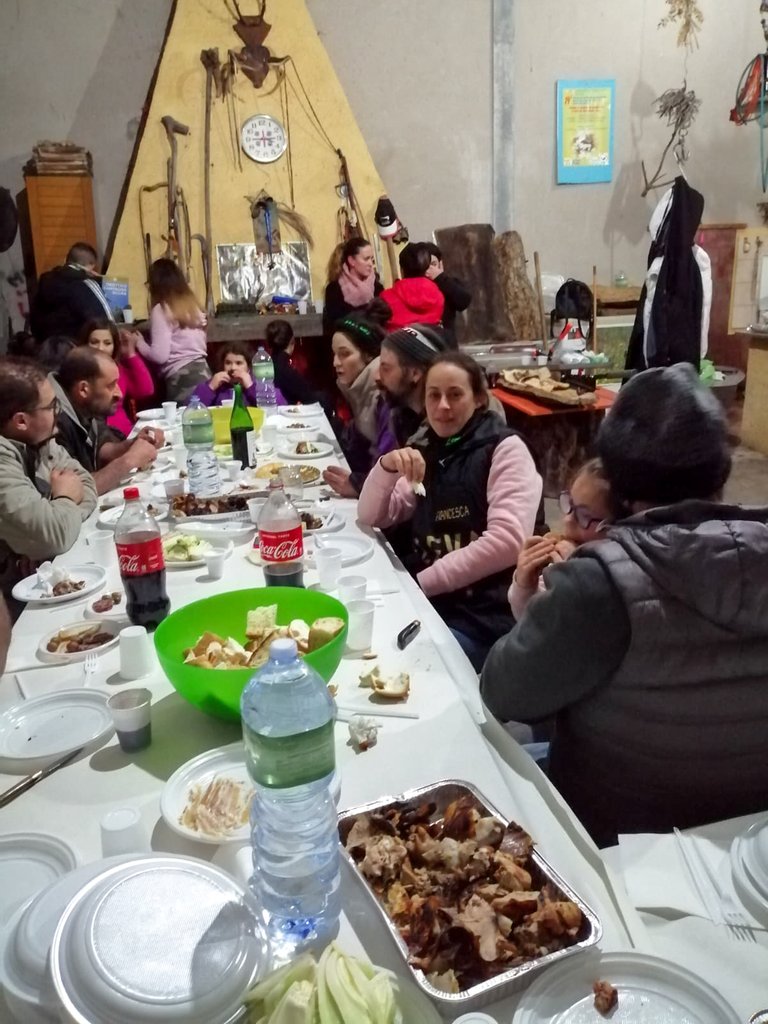


Finalmente dopo circa 4/5 ore la carne è quasi pronta, e si inizia con il pranzo. Le donne organizzatrici, servono gli invitati, si fa il bis degli antipasti, e dopo si passa alla pasta. Gli uomini, mangiano fuori davanti al fuoco, la carne dev’essere controllata perché non ci siano imprevisti, e perché alla fine della cottura, è molto importante l’ultimo passaggio. Questo consiste nell’avvolgere un bel pezzo di lardo di maiale (questo perché ci piacciono i cibi leggeri), in un pezzo di carta, scaldarlo nel fuoco fino a che la carta non inizia a bruciare e il lardo inizia a sciogliersi. Una volta che il lardo inizia a sciogliersi , si fa colare sulla carne ormai già pronta. Questo viene fatto, perché il lardo da quel tocco in più a queste pietanze per me deliziose.
Finally after about 4/5 hours the meat is almost ready, and we start with lunch. The women organizers serve the guests, make an encore of appetizers, and then move on to pasta. The men eat outside in front of the fire, the meat must be checked so that there are no unexpected events, and because at the end of cooking, the last step is very important. This consists of wrapping a nice piece of pork lard (this is because we like light foods), in a piece of paper, heating it in the fire until the paper starts to burn and the lard starts to melt. Once the lard begins to melt, it is poured onto the meat which is now ready. This is done, because the lard gives that extra touch to these dishes that are delicious for me.

Il pranzo prosegue con formaggi, dolci di mandorle e l’immancabile Pani ‘e Saba (Pan di Sapa), il dolce fatto apposta in questo periodo dell’anno per l’occasione di questa festa. Su Pani 'e Saba, è un impasto di mandorle, nocciole, mosto di vino, farina, semola, uvetta, buccia di arancia essiccata, mandorle,lievito madre, sale, anice, canditi e spezie miste. Vengono uniti tutti gli ingredienti, e vendono lasciati riposare per 36 ore coperto, con una temperatura costante. Dopo vengono fatte le forme, che solitamente è quella di un crapfen, e si inforna. Finito il pranzo, si continua a cantare, bere ( i più coraggiosi iniziano a bere Fillu‘ e Ferru, sarebbe l’acquavite), giocare a Sa Murra, ballare, fino al momento della partenza del trattore che porterà il tronco in piazza.
Lunch continues with cheeses, almond sweets and the ever-present Pani 'e Saba (Pan di Sapa), the sweet made especially at this time of year for the occasion of this celebration. Su Pani 'e Saba is a mixture of almonds, hazelnuts, wine must, flour, semolina, raisins, dried orange peel, almonds, sourdough, salt, aniseed, candied fruit and mixed spices. All the ingredients are combined, and they are left to rest for 36 hours covered, with a constant temperature. Then the shapes are made, which is usually that of a crapfen, and baked. After lunch, we continue to sing, drink (the bravest start drinking Fillu 'e Ferru, it would be the brandy), play Sa Murra, dance, until the time for the tractor to take the trunk to the square.

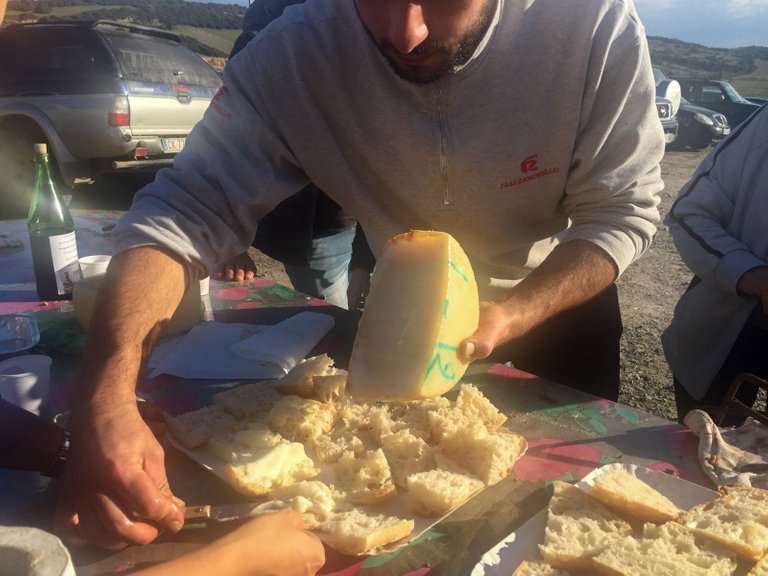
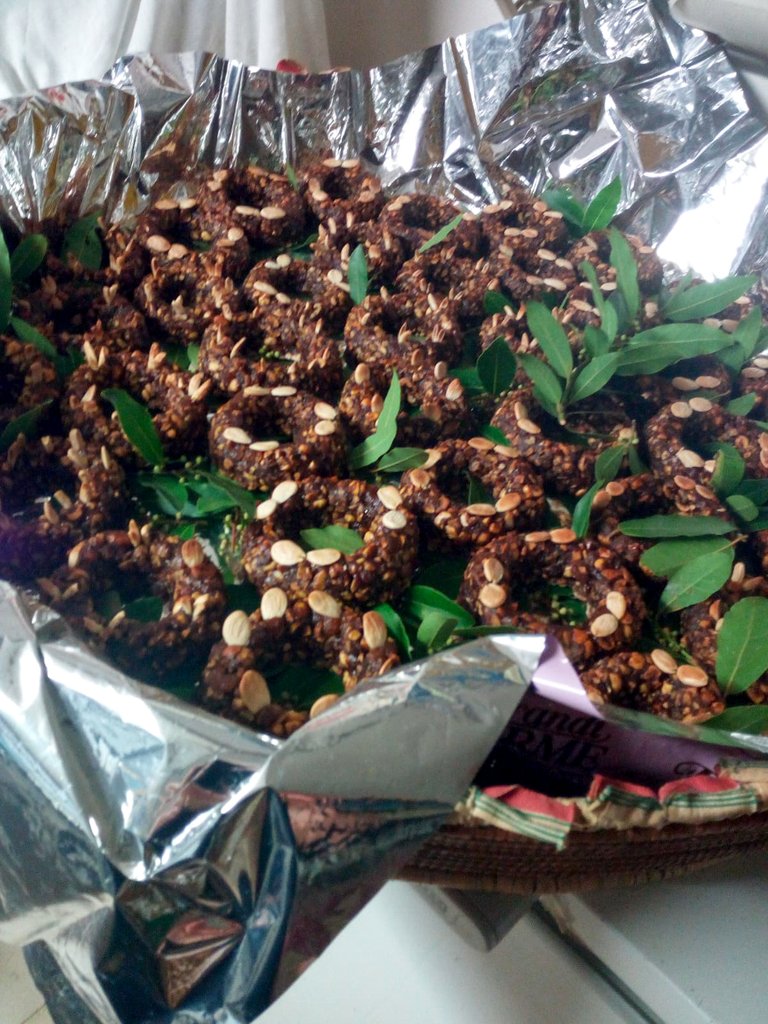
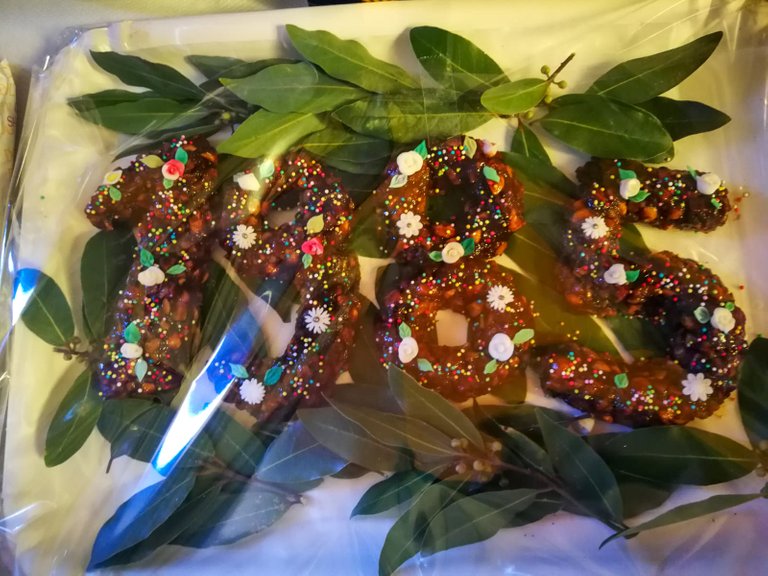

Adesso arriva il momento, secondo me, più bello di tutta la giornata. Il tragitto dal posto dove si è svolto il pranzo fino in chiesa. Da anticipare che il percorso è lungo qualche km, ma tra una fermata e l’altra, si arriva nella piazza della Chiesa, a pomeriggio inoltrato. Si parte e inizia il divertimento… il trattore è addobbato a festa, con davanti una decorazione di arance, con una sirena in modo che si senta la melodia che accompagnerà i festeggiamenti per tutto il percorso. Il trattore è seguito da persone a piedi e dalle macchine, le quali vengono preparate con delle cassa per la musica per farsi sentire da lontano. Il paese deve sentire che si sta arrivando, in modo che ci sia una vera festa nella piazza del municipio, tappa obbligatoria da fare prima di arrivare in chiesa.
Gli organizzatori percorrono il tragitto sul carrello del trattore dove c’è il tronco, qui si canta Antonio stiamo arrivando, stiamo arrivando, oppure un gruppo urla S’Antantò e l’altro risponde Toidoooo questo per due o tre volte, e dopo tutti insieme urlano Tocca su Fogonne ‘e S’Antantò Toidoooo.. Lo so possiamo sembrare matti, però bisognerebbe partecipare a questa festa almeno una volta nella vita per poter iniziare a capire che cosa scaturisce in noi questa festa…
Now comes the moment, in my opinion, the most beautiful of the whole day. The journey from the place where lunch took place to the church. It should be anticipated that the route is a few km long, but between one stop and another, you arrive in the church square, in the late afternoon. Let's go and the fun begins... the tractor is festively decorated, with a decoration of oranges in front, with a siren so that you can hear the melody that will accompany the celebrations throughout the journey. The tractor is followed by people on foot and by cars, which are set up with music boxes to be heard from afar. Town must feel that you are coming, so that there is a real party in the town hall square, an obligatory stop before arriving at the church.
The organizers travel the route on the tractor where the trunk is, here we sings, Antonio we are arriving, we are arriving, or one group yells S'Antantò and the other replies Toidoooo this two or three times, and then all together shout Tocca su Fogonne 'e S'Antantò Toidoooo.. I know we may sound crazy, but we need to participate in this party at least once in our life to be able to begin to understand what this party brings about in us…

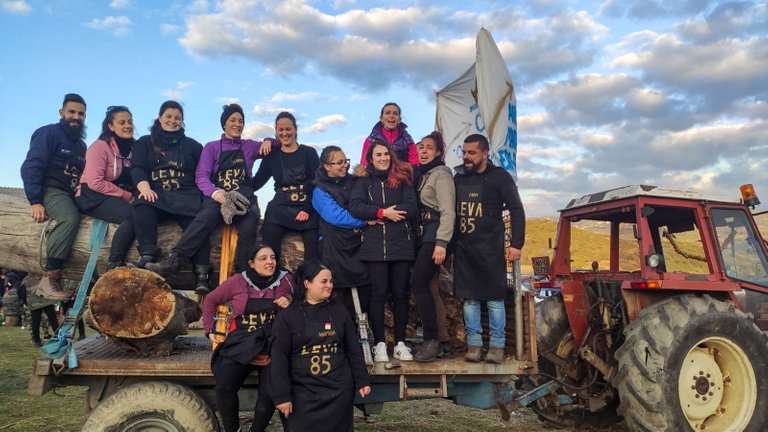

Una volta arrivati al centro del paese, ci si ferma a ballare, cantare , suonare, offrire del vino o del Fillu ‘e Ferru ai passanti che sono arrivati per vedere i festeggiamenti. Alcune volte ci si trova anche con due gruppi di organizzatori dei pranzi nello stesso momento, e allora il divertimento è garantito. Dopo balli e canti, si prosegue in direzione della Chiesa. Arrivati qui, con molta attenzione viene scaricato il tronco nella piazza dove verrà acceso il Falò il 16 gennaio. I festeggiamenti non possono finire così, infatti ritorna in campagna a passare un altro po’ di tempo insieme per mangiare e bere nuovamente. Questo è ciò che succede nei primi weekend di gennaio, oltre ai giorni del primo e sei gennaio essendo giorni di festa.
Once you get to the center of the town, you stop to dance, sing, play, offer wine or Fillu 'e Ferru to passers-by who have arrived to see the festivities. Sometimes there are even two groups of lunch organizers at the same time, and then the fun is guaranteed. After dancing and singing, we continue in the direction of the Church. Once here, the trunk is carefully unloaded in the square where the bonfire will be lit on 16 January. The celebrations can't end like this, in fact he returns to the countryside to spend some more time together to eat and drink again. This is what happens on the first weekends of January, in addition to the days of January 1st and 6th being holidays.

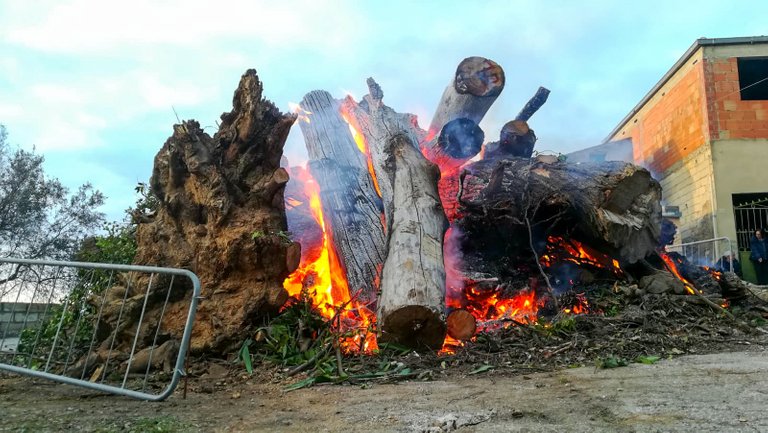

Arriva il 16 gennaio, il giorno che inizia la festa religiosa, che durerà fino al giorno dopo. Qui ahimè so poco, giusto che viene celebrata la messa nella Chiesa principale, e poi in processione viene portato il Santo in spalla.
Per tradizione l’accensione del Falò avviene alle 16.30, poco prima che il Santo arrivi nella Piazza. Una volta arrivati, vengono fatti tre giri da un lato e dall’altro con il santo in spalla, mentre il Prete benedice il fuoco. Il Santo dopo viene portato nella sua Chiesa, dove rimarrà fino al giorno dopo. Verrà celebrata la messa, e sempre in processione, verrà accompagnato nuovamente nella Chiesa principale del paese.
January 16 arrives, the day that the religious festival begins, which will last until the following day. Alas, I know little here, just that mass is celebrated in the main church, and then the saint is carried on his shoulder in procession. Traditionally, the bonfire is lit at 4.30 pm, shortly before the saint arrives in the square. Once they arrive, they are made three turns from one side to the other with the saint on his shoulder, while the Priest blesses the fire. The saint is then taken to his church, where he will remain until the following day. Mass will be celebrated, and always in procession, he will be accompanied back to the main church of the town.

Intanto, continuano i festeggiamenti civili, si esibisce la maschera tipica del paese, cioè Su Corongiaiu, la tipica maschera Laconese che apre anche il carnevale, si prepara una grossa griglia dove si riscaldano panini e si cucinano salsicce, e naturalmente non può mancare il vino… Tutta la sera si canta, si balla e si mangia in compagnia. Questo non succede solo nella piazza della Chiesa, ma anche in vari rioni del paese, dove i vicini hanno organizzato la stessa festa in miniatura. Per ora è tutto, cari amici, spero vi sia piaciuto il mio racconto, e che vi abbia incuriosito. Se capitate in Sardegna in quel periodo, fate tappa a Laconi, così potrete vivere questa bellissima esperienza.
La leggenda narra che Sant’Antonio, sia sceso all’inferno e abbia sfidato dei demoni ai quali ha rubato una favilla incandescente, l’abbia portata sulla terra e che abbia regalato il fuoco all’intera umanità. Questa festa in Sardegna è moto sentita perché, essendo una terra dove si vive di agricoltura e pastorizia, sui contadini e pastori ha un forte ascendente, infatti l’accensione del fuoco, rappresenta un momento di preghiera, riflessione per sperare e chiedere al santo la grazia per un raccolto abbondante. Vi ringrazio per aver letto tutto il racconto di questa festa, spero sia riuscita a trasmettere l'effetto che fa a noi sardi.
Meanwhile, the civil celebrations continue, the typical mask of the town is exhibited, that is Su Corongiaiu, the typical Laconese mask which also opens the carnival, a large grill is prepared where sandwiches are heated and sausages are cooked, and of course wine cannot be missing… All evening we sing, dance and eat together. This doesn't just happen in the church square, but also in various districts of the town, where the neighbors have organized the same miniature party. That's all for now, dear friends, I hope you enjoyed my story, and that it intrigued you. If you happen to be in Sardinia at that time, make a stop in Laconi, so you can live this beautiful experience.
Legend has it that St. Anthony descended into hell and challenged demons from whom he stole an incandescent spark, brought it to earth and gave fire to all humanity. This feast in Sardinia is deeply felt because, being a land where one lives from agriculture and sheep farming, it has a strong influence on farmers and shepherds, in fact the lighting of the fire represents a moment of prayer, reflection to hope and ask the saint for grace for a bountiful harvest. Thank you for reading the whole story of this party, I hope it has managed to convey the effect it has on us Sardinians.

Le foto che vedete, mi sono state gentilmente donate da mia sorella, la quale ha partecipato qualche anno fa come organizzatrice della festa, in quanto anche se in passato io ho partecipato, non avevo nessuna foto.
The photos you see were kindly donated to me by my sister, who participated a few years ago as organizer of the party, as even if I participated in the past, I didn't have any photos.

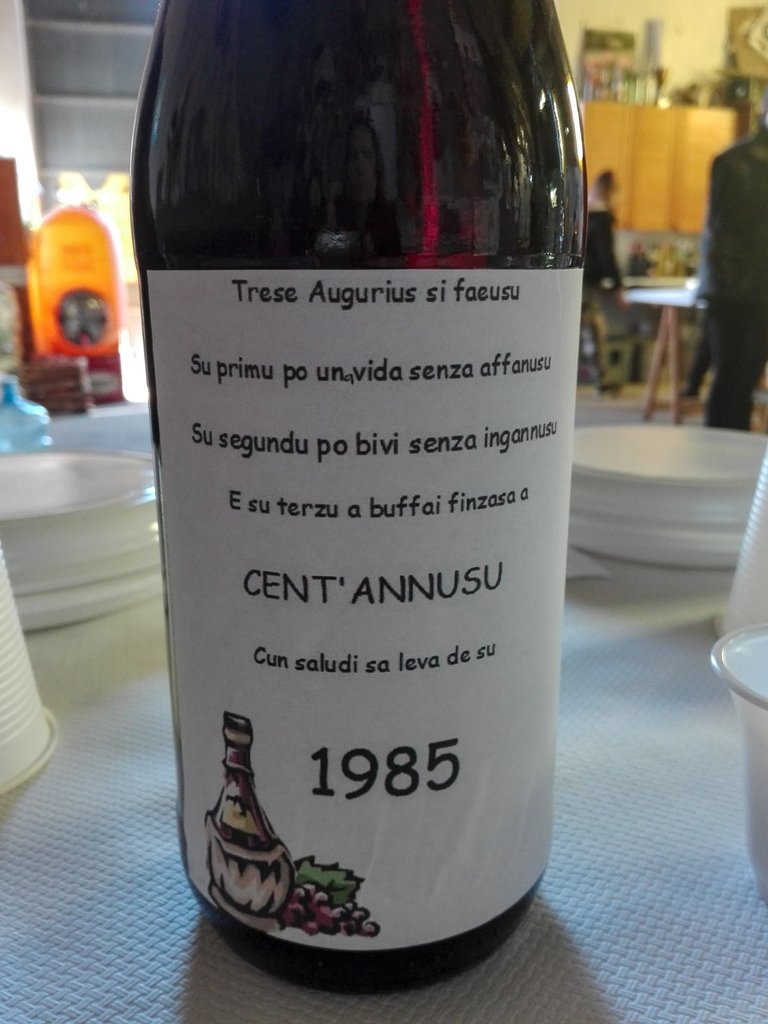
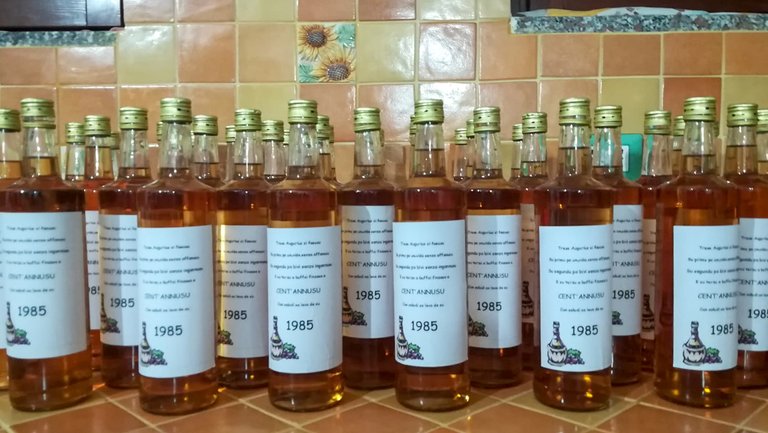
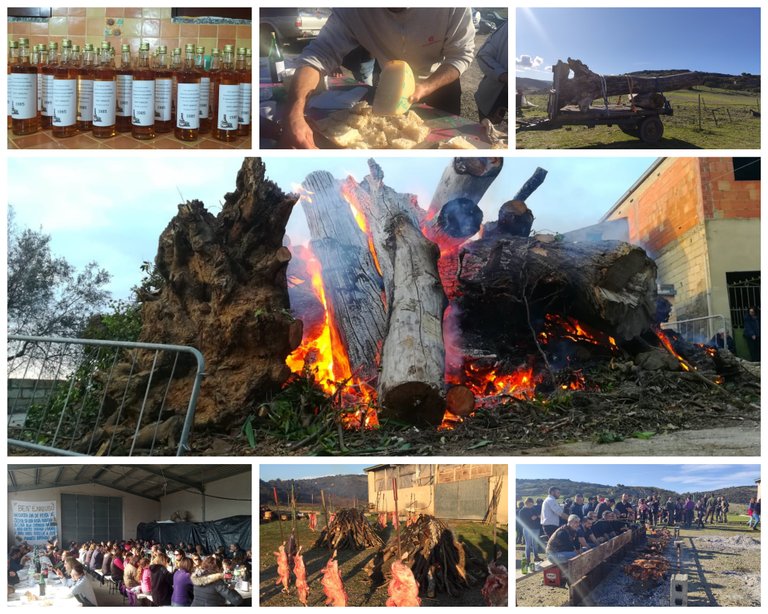

Prima di salutarvi, vi traduco la dedica che ogni leva fa ai suoi invitati nel giorno del pranzo. Tre cose vi auguriamo:
Con Salute La Leva del 1985.
Con questo è tutto amici. Grazie e al prossimo post.
Before saying goodbye, I'll translate the dedication that every conscript makes to his guests on lunch day. Three things we wish you:
The first, a life without worries
The second, a life without deception
The third, of drink up to
ONE HUNDRED YEARS
With health the lever of 1985.
That's all friends. Thanks and see you next post.

All images in this post with no declared source, are property of the author @giovi86
Congratulations @giovi86! You have completed the following achievement on the Hive blockchain And have been rewarded with New badge(s)
Your next target is to reach 600 upvotes.
You can view your badges on your board and compare yourself to others in the Ranking
If you no longer want to receive notifications, reply to this comment with the word
STOPTo support your work, I also upvoted your post!
Check out our last posts:
Support the HiveBuzz project. Vote for our proposal!
Vabbé ma questa festa è fenomenale!
Devo viverla almeno una volta prima di morire o andrò via con un rimpianto lol!
Io poi sono un estimatore delle feste popolari... Mi chiamo anche Antonio... Come posso mancare? Mi organizzerò al più presto!
Comunque, come al solito, mi hai fatto venire fame.🤣
Ti posso garantire che è una delle feste paesane più belle alla quale io abbia mai partecipato...
Magari un giorno parteciperai, mai dire mai...
Anche a me è venuta fame mentre scrivevo e guardavo le foto😜😜😜
Ah si sono anche io per il mai dire mai... poi basta organizzarsi eh eh!
Yay! 🤗
Your content has been boosted with Ecency Points, by @giovi86.
Use Ecency daily to boost your growth on platform!
Support Ecency
Vote for new Proposal
Delegate HP and earn more
@tipu curate
Upvoted 👌 (Mana: 24/44) Liquid rewards.
Che belle le feste popolari e hai fornito un racconto e una descrizione davvero ampia e bella di questa festa.
Bravissima
!CTP
!discovery 35
E' una festa che fa parte di me, adesso è qualche anno che non partecipo, ma spero che per i 40 riuscirò a partecipare nuovamente. Sono felice che ti sia piaciuta, anche perchè quando scrivevo come ho detto a @p1k4ppa10 oltre a essermi venuta fame, era come se stessi vivendo il tutto.. Grazie ancora per il supporto🙏🙏🙏
This post was shared and voted inside the discord by the curators team of discovery-it
Join our community! hive-193212
Discovery-it is also a Witness, vote for us here
Delegate to us for passive income. Check our 80% fee-back Program